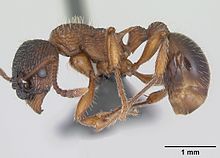
Summary
Myrmica schencki is a species of ant in the genus Myrmica.
| Myrmica schencki | |
|---|---|

| |
| Worker | |
| Scientific classification | |
| Domain: | Eukaryota |
| Kingdom: | Animalia |
| Phylum: | Arthropoda |
| Class: | Insecta |
| Order: | Hymenoptera |
| Family: | Formicidae |
| Subfamily: | Myrmicinae |
| Genus: | Myrmica |
| Species: | M. schencki
|
| Binomial name | |
| Myrmica schencki Viereck, 1903
| |
Distribution and habitat edit
Myrmica schencki is distributed across Europe (from Great Britain, Sweden, Finland in the North to Spain, Italy and the Balkans in the South), the Caucasus, Turkey, also in West Siberia, Kazakhstan, the Tien-Shan and Altai Mountains, and near Krasnoyarsk in East Siberia. It inhabits dry habitats in open areas and forests. Nests are found in the ground, occasionally in tussocks of grass or moss. Colonies are polygynous with up to 1000 workers. Recent research has shown that this species may partially feed on pollen – a phenomenon rarely documented in ants.[citation needed]
Parasitism edit
M. schencki is parasitized by Phengaris rebeli larvae, which release chemicals that trick the ants into believing that the butterfly larvae are ant larvae and should be brought back to the ant brood.[1] In the ant nest, the P. rebeli larvae and pupa are able to mimic the sound that the queen of the ant colony makes, causing the ants to preferentially feed the P. rebeli larvae over their own larvae.[2] While the workers are unable to distinguish the queen from the P. rebeli larvae and pupa, the queen begins to treat the P. rebeli larvae and pupa as rivals.[3] Less commonly, M. schecncki may also be parasitized by Phengaris arion.[4] Unlike P. rebeli, P. arion adopts more of a predatory relationship with the ants which is generally viewed as a less successful strategy.[5]
References edit
- ^ Akino, T; JJ Knapp; JA Thomas; GW Elmes (1999). "Chemical mimicry and host specificity in the butterfly Maculinea rebeli, a social parasite of Myrmica ant colonies". Proceedings of the Royal Society B. 266 (1427): 1419–1426. doi:10.1098/rspb.1999.0796. PMC 1690087.
- ^ Thomas, JA; Schonrogge K; Bonelli S; Barbero F; Balletto E (2010). "Corruption of ant acoustical signals by mimetic social parasites: Maculinea butterflies achieve elevated status in host societies by mimicking the acoustics of queen ants". Communicative & Integrative Biology. 3 (2): 1–4. doi:10.4161/cib.3.2.10603. PMC 2889977. PMID 20585513.
- ^ Barbero, Francesca; Thomas JA; Bonelli S; Balletto E; Schonrogge K (2009). "Queen ants make distinctive sounds that are mimicked by a butterfly social parasite". Science. 323 (5915): 782–785. Bibcode:2009Sci...323..782B. doi:10.1126/science.1163583. PMID 19197065.
- ^ Thomas, J.A.; J.C. Wardlaw (1990). "The effect of queen ants on the survival of Maculinea arion larvae in Myrmica ant nests". Oecologia. 85 (1): 87–91. Bibcode:1990Oecol..85...87T. doi:10.1007/bf00317347. PMID 28310959.
- ^ Thomas, Jeremy; Josef Settele (2004). "Evolutionary biology: Butterfly mimics of ants". Nature. 432 (7015): 283–284. Bibcode:2004Natur.432..283T. doi:10.1038/432283a. PMID 15549080.
- Csősz S, Markó B, Gallé L 2011. The myrmecofauna (Hymenoptera: Formicidae) of Hungary: an updated checklist North-Western Journal of Zoology 7: 55-62.
- Czekes Z et al. 2012. The genus Myrmica Latreille, 1804 (Hymenoptera: Formicidae) in Romania: distribution of species and key for their identification Entomologica romanica 17: 29-50.
- Czechowski W et al. 2011. Rubbish dumps reveal the diet of ant colonies: Myrmica schencki Em. and Myrmica rubra (L.) (Hymenoptera: Formicidae) as facultative pollen-eaters Polish Journal of Ecology 56: 737-741.
External links edit
- Media related to Myrmica schencki at Wikimedia Commons


